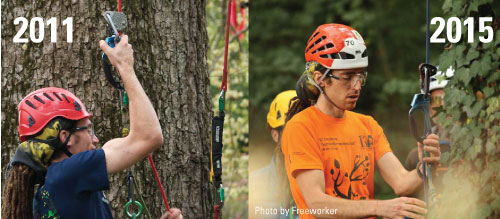As far back as 2011 James Kilpatrick experimented with a modified SRT Ascent System – read a previous blog post on the subject here.
Readers new to SRT should not confuse James’ system with SRT work positioning configurations and devices commonly employed today.
The Single Line Ascent System James has developed is based on the traditional 'frog' system and is specifically designed for ascent.
Most climbers using this style of ascent, requiring the use of an independent ascent line, set a pulley-based anchor aloft on completing the ascent, and transition to a DbRT climbing system.
European cavers developed the first ‘frog’ systems (as documented in On Rope by Smith and Padgett).
Tree climbers saw the benefits of ‘frog’ ascent system and adapted it for tree work.
But the reason for ascent differs between cavers and tree climbers.
Climbing strategy differences
Tree climbers ascend to get in while cavers ascend to get out.
The vice-versa is therefore true: cavers descend to get into the cave whereas tree climbers descend to get out of the tree.
This means each discipline (cavers and tree climbers) has very different functionality requirements from the same configuration.
Frog systems are extremely efficient for ascent but simply will not work on descent.
If rapid descent is required (and there are many reasons why you might need to descend in a hurry when tree climbing) the climber cannot easily detach themselves from the system in order to commence the descent.
As far as SRT ascent systems go the ‘frog’ is considered well-organized and easy to set up but can be challenging to master efficiently and, as discussed, difficult to get off in a hurry.
Aside from these tree climbing limitations SRT ascent systems still have a very valid place in the tree climbers toolbox (hence the use of such a system by one of the world’s leading tree climbers).
Without going into the intricacies of the traditional ‘frog’ set-up, James has revolutionized the concept by introducing the Petzl Micro Traxion above the hand ascender, replacing the need for a towable chest ascender positioned low on the chest below the hand ascender as back-up.
Because James’ system is a departure from the traditional ‘frog’ ascent system the judges in the 2015 German National TCC questioned its appropriateness for use in tree climbing.
But James (being James) had done his homework – see James’ blog post on the subject here.
Earlier this year Petzl’s Quality and Technical Director Bernard Bressoux 'endorsed' the use of the Petzl Micro Traxion to back-up the Petzl Ascension or Ascentree connected via the Petzl OK – download Petzl’s Statement here for more details.
But be cautioned - the Petzl Statement comes with a proviso; the user should make their own risk analysis to determine if this solution is appropriate for their environment.
One thing is certain; James is bound to agree with Bernard’s sentiment.

